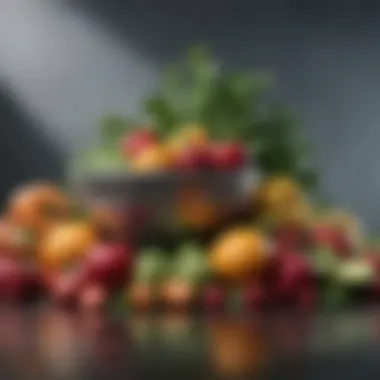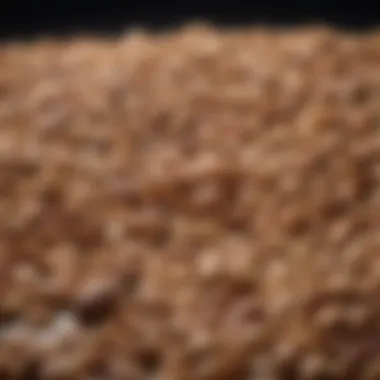Comprehensive Clean Food List for Optimal Health


Intro
The journey towards better health often starts with what we put on our plates. In recent years, there has been a burgeoning interest in clean eating, yet many still wonder: what exactly does this mean? Clean eating is not just a passing trend; it revolves around nourishing the body with whole, unprocessed ingredients. It prioritizes fresh, natural foods over those laden with additives and preservatives.
Understanding clean eating is crucial for anyone looking to optimize their nutrition. This guide seeks to demystify the concept and provide a roadmap for incorporating clean foods into your daily meals. By delving into categories of clean foods, we can take intentional steps toward better health—and along the way, it's essential to consider how preparation methods and food sourcing can elevate our dietary choices.
The Concept of Clean Eating
Clean eating has grown into a popular philosophy surrounding dietary choices and lifestyles. At its core, it focuses on consuming whole, unprocessed foods that nourish the body and provide essential nutrients—reflecting a natural state of food. This concept isn’t merely a diet; rather, it embodies a lifestyle—one that can shape not only physical health but also mental well-being. The significance of clean eating lies in the ability to optimize one’s health through intentional food selections and conscious eating habits.
Defining Clean Eating
Clean eating isn’t about stringent rules or counting calories; it’s a nuanced framework that encourages choosing whole foods over processed items. Think of it as selecting foods that could, in theory, be harvested from the earth. These include fruits, vegetables, lean proteins, nuts, seeds, and whole grains. In practical terms, clean eating means avoiding refined sugars, artificial flavors, and preservatives. By aligning eating habits with natural food sources, individuals often experience improved energy levels, weight management, and reduced risk of chronic diseases.
Health Benefits of Clean Eating
Engaging in clean eating can yield a myriad of health benefits. By optimizing one’s diet, individuals can experience:
- Enhanced Nutrient Intake: Whole foods are packed with vitamins, minerals, and antioxidants—elements that help maintain a robust immune system and overall health.
- Weight Management: Natural foods often have lower calorie density combined with higher nutrient value, making it easier to consume fewer calories while feeling full.
- Improved Digestion: Whole foods, particularly fiber-rich fruits and veggies, promote digestive health, supporting regular bowel movements and a healthy gut microbiome.
- Increased Energy: Consuming foods with low glycemic indexes fuels the body steadily, preventing energy spikes and crashes throughout the day.
Research suggests that individuals who adopt clean eating habits may also enjoy better mental clarity, mood stability, and even improved skin health. When folks fuel their bodies with nutritious foods, it stands to reason they’ll feel better physically and mentally.
Common Misconceptions
Despite its rising popularity, clean eating is often misunderstood. It’s not just a trendy fad; it’s a step towards holistic wellness. Here are some common misconceptions:
- Clean Eating is Expensive: While some organic items can be pricey, clean eating isn't exclusively about buying organic. Seasonal and local produce can be much more affordable and just as nutritious.
- It Requires Rigid Rules: Many believe clean eaters must follow strict guidelines. In reality, it’s about balance and making healthier choices without feeling deprived.
- All Processed Foods are Bad: Not all processed foods are created equal. Some minimally processed options, like frozen vegetables or canned beans, can still be part of a clean eating plan.
Understanding Clean Food Categories
Understanding clean food categories is like navigating the intricacies of a well-loved recipe. Each ingredient plays its unique role in nourishing the body while offering a treasure trove of benefits. By recognizing these categories, individuals can make informed choices that lead not only to optimal health but also to an enhanced overall well-being. When we categorize foods as clean, we strip away the complications and focus on quality, ensuring our meals fuel rather than hinder us.
Diving into these categories not only sheds light on the essentials of nutrition but also cultivates a deeper appreciation for the food we consume. By incorporating a variety of clean food categories—fruits and vegetables, whole grains, nuts and seeds, proteins, and healthy fats—we can weave together a balanced diet that meets our body's multifaceted demands.
Fruits and Vegetables
Fruits and vegetables stand as the cornerstone of a clean eating framework. They pack a punch with vitamins, minerals, and antioxidants that boost our immune system and promote good health. In terms of varieties, think of colorful fruits like strawberries, blueberries, and kiwi basking in sunlight, alongside a bouquet of vegetables ranging from leafy greens to bright bell peppers. This colorful palette doesn't just look appealing; it's a hint at the nutrients packed within.
Incorporating a rainbow of fruits and veggies can help in:
- Reducing inflammation
- Lowering the risk of chronic diseases
- Improving digestion
Moreover, eating these whole foods promotes satiety, which can help in managing weight and maintaining energy levels throughout the day. It’s important, though, to choose organic options when possible to minimize exposure to pesticides and chemicals.
Whole Grains
Whole grains are another vital player in the clean food game; they provide us with sustainable energy and fiber to help keep our digestive systems running smoothly. Unlike refined grains, which have been stripped of their essential nutrients, whole grains maintain their bran, germ, and endosperm.
Quinoa, brown rice, oats, and barley fall into this wholesome category. These foods are not only filling but also slow digesting, meaning your blood sugar levels won't spike, helping stave off those mid-afternoon slumps. Including whole grains in your meals may help in:
- Reducing the risk of heart disease
- Promoting weight loss
- Supporting gut health
Nuts and Seeds


Next up are nuts and seeds, often considered nature's little powerhouses. They’re packed with healthy fats, protein, and essential nutrients that play a crucial role in maintaining heart health and brain function.
Almonds, walnuts, chia seeds, and flaxseeds are excellent for snacking or adding crunch to your meals. Incorporating these tiny wonders in your diet can aid:
- Inflammation reduction
- Mood stabilization
- Enhanced cognitive function
As they contain significant calories, moderation is key—just a handful can provide the needed nutrient boost.
Proteins Sources
Protein is the building block of life, crucial for repairing tissues and producing enzymes and hormones. When talking clean eating, choose lean sources like chicken, turkey, fish, beans, and legumes. Including a variety of proteins ensures that your body accesses all the essential amino acids it needs.
Fish, particularly fatty varieties like salmon and trout, are not only rich in protein but also omega-3 fatty acids which are known to benefit heart health. Including proteins in your diet can also help in:
- Enhancing muscle growth and maintenance
- Supporting immune function
- Promoting satiety
Healthy Fats
It’s a common misconception that all fats are harmful; however, healthy fats are essential for overall health. They aid in nutrient absorption and provide energy. Avocados, olive oil, and fatty fish belong here, giving our bodies the crucial support needed for cellular integrity and hormonal balance.
Including healthy fats in your meals can lead to:
- Improved cardiovascular health
- Better weight management
- Enhanced brain function
Healthy fats, when consumed in moderation, can be the secret ingredient to shining bright in both health and vitality.
By understanding these clean food categories, one can begin to construct a balanced plate that not only satisfies hunger but also fuels the body in a holistic manner.
Navigating Processed Foods
Processed foods have become a staple in our modern diet, yet not all processed options carry the same weight in terms of health impact. Understanding how to navigate these foods is vital for anyone looking to optimize their health and well-being. This section aims to equip you with the tools necessary to differentiate between healthier and less favorable processed foods. By grasping the nuances of food processing and labeling, you can make more informed choices that align with your clean eating goals.
Identifying Unhealthy Processed Foods
Processed foods are often laden with ingredients that can sabotage one’s health journey. Common indicators of unhealthy options include excessive added sugars, sodium, and unhealthy fats. Here are some signs to watch for:
- Long ingredient lists often mean more additives.
- Ingredients like high fructose corn syrup and artificial preservatives are red flags.
- Foods that are marketed as "low-fat" but are high in sugar often do more harm than good.
Many people find themselves relying on convenience foods, but frequent consumption of items like sugary cereals or microwave meals can lead to a myriad of health issues, ranging from weight gain to increased risk of chronic diseases.
Understanding Food Labels
When it comes to making health-conscious choices, food labels are your best friend—if you know how to decode them. Look out for:
- Serving Size: Always check this first. A larger serving can make calorie counts misleading.
- Nutritional Values: Focus on high fiber, low added sugars, and balance of macronutrients.
- Ingredient List: Ingredients are listed by volume. If whole foods, like whole grains or vegetables, aren’t at the top of the list, reconsider.
"An informed consumer is a powerful one"—the more you know about what goes into your body, the better you can eat.
If you find terms like "natural" or "organic" on a package, remember they don’t automatically guarantee health benefits. With the rising trend of health marketing, some labels can be misleading, masking unhealthy items in seemingly attractive packaging.
The Impact of Additives
Food additives are everywhere, and their presence can substantially alter the health profile of a product. These substances serve various purposes, from preserving shelf life to enhancing flavor, but many come with concerns:
- Preservatives: While they prevent spoilage, some have been linked to health issues, such as allergies and headaches.
- Flavor Enhancers: Ingredients like monosodium glutamate (MSG) are often used to boost umami flavors but can trigger sensitivities in some individuals.
- Coloring Agents: Artificial colors may appeal visually but contribute little nutritional value and raise health concerns.


In trying to avoid these additives, focus on whole, minimally processed foods instead. The less interference in the food's natural state, the better it often is for your health.
The Importance of Sourcing Clean Foods
Sourcing clean foods is more than just a trend; it’s a necessary pillar for anyone keen on elevating their health and enhancing the nutritional quality of their diets. Going beyond mere labels, this process involves understanding where your food comes from and how it's produced. By making informed choices about food sourcing, individuals not only reap the benefits of superior nutrition but also contribute positively to the environment and local economies.
A significant aspect of this sourcing journey centers around the quality of the produce. Clean foods typically come with a host of health advantages, such as reduced pesticide exposure and higher nutrient density. Additionally, knowing the origin of food builds a connection between consumers and producers, fostering trust and transparency. Here’s how to navigate this landscape effectively:
Local vs. Organic Produce
When pondering between local and organic, it's essential to recognize that both have their merits. Local produce often finds its way to tables faster than organic options sourced from farther away, which may lose freshness during transit. Freshness means better flavor and more nutrients. Plus, local farmers often practice sustainable methods, even if they aren’t certified organic, resulting in wholesome food.
On the other hand, organic produce adheres to strict regulations prohibiting synthetic fertilizers and pesticides. This leads to food that's generally gentler on the body, and, depending on the brand, may also uphold ethical farming practices that benefit soil health and biodiversity.
Thus, striking a balance between local and organic produce allows consumers to enjoy the best of both worlds. To avoid confusion, keep this in mind:
- Know Your Farmer: Engage with local markets, ask questions about their practices, and cultivate connections.
- Research Organic Labels: Not all organic farms are equal. Learn about their sourcing methods to ensure they align with your values.
Understanding Seasonal Eating
Another important piece of the clean food puzzle is seasonal eating. Embracing foods that are in season not only supports local agriculture but also enhances your diet’s diversity. Seasonal produce tends to be fresher, tastier, and more nutrient-dense. Think about tomatoes in summer or apples in the fall—these fruits are at their peak flavor and nutritional profile.
Eating seasonally is beneficial for both the palate and the purse. Local seasonal foods often come at lower prices, since they don’t need to be transported long distances. To facilitate seasonal eating:
- Educate Yourself: Keep a seasonal produce calendar to understand what’s available in your area each month.
- Get Creative: Use seasonal ingredients to experiment with new recipes, broadening your culinary repertoire.
Supporting Ethical Farming Practices
As consumers become more conscious of their food choices, supporting ethical farming practices stands out as a crucial responsibility. Ethical farming doesn’t just aim for profit; it focuses on creating a sustainable ecosystem that respects animal welfare and soil health. Many consumers now look for farms that practice crop rotation, reduce chemical use, and treat animals humanely.
By choosing to buy from farmers who uphold these principles, you foster a food system that:
- Promotes Biodiversity: Diversity in crops improves resilience against pests and diseases, leading to healthier ecosystems.
- Respects Animal Welfare: Support farms that prioritize humane treatments, considering the ethics of how animals are raised and processed.
To make a positive impact, consider:
- Researching Certifications: Look for farms with certifications like Free Range or Animal Welfare Approved.
- Visiting Farms: If possible, visit local farms to see firsthand how animals are treated and crops are grown.
By sourcing clean foods, you not only prioritize your health but also contribute to a sustainable future for the planet.
Preparation Methods for Clean Eating
Preparation methods for clean eating are vital; they play a significant role in ensuring that the nutritional integrity of the food we consume is maintained. How we cook, store, and organize our meals greatly influences not just flavor, but also the health benefits we derive from our diet. Engaging with the right techniques can enhance the wholesome qualities of fresh produce and ingredients, making healthy eating both enjoyable and sustainable.
Cooking Techniques
When it comes to cooking, a variety of techniques can be utilized for clean eating. Steaming, grilling, baking, and sautéing are some of the preferred methods. Each method has its advantages!
- Steaming preserves nutrients better than boiling, as it allows food to retain water-soluble vitamins that might otherwise leach out.
- Grilling imparts a rich, smoky flavor while reducing unnecessary fats, thanks to excess grease dripping away.
- Baking is a wonderful way to cook without adding oils or fats, especially when preparing vegetables and lean proteins. This method can offer a crunchy finish without compromising on health.
- Sautéing with a splash of water or broth instead of oil also helps to keep dishes light yet flavorful.
When choosing a method, consider the ingredients as well. For example, root vegetables often benefit from roasting, which enhances their natural sweetness, while leafy greens are best enjoyed lightly steamed to maintain their vibrant color and crispness.
Meal Prepping Strategies
Meal prepping can save time and promote better eating habits, ensuring that when hunger strikes, health-conscious choices are readily available. Well executed meal prep eliminates the temptation of reaching for convenience foods that may not adhere to clean eating principles. Here are some tips to maximize your meal preparation efforts:


- Plan Ahead: Devote time each week to plan recipes and shop for ingredients. This not only saves time but also ensures that you have all necessary components.
- Batch Cooking: Cooking larger portions of grains like quinoa or brown rice can yield several servings, reducing the need to cook every day. They can be stored in the fridge to accompany various meals during the week.
- Portioning: Divide meals into individual containers for an easy grab-and-go option. This way, you’re more inclined to choose your prepped food over unhealthy fast food.
- Variety: To avoid boredom with your meals, mix it up. Cook different proteins, veggies, and grains weekly.
Taking just a bit of time each week to prep can significantly improve not only your nutrition but also your overall eating experience.
Preservation Methods
Proper storage and preservation of clean foods are crucial to extending their lifespan and maintaining freshness. Here are a few preservation techniques to keep in mind:
- Freezing: One of the best ways to keep fruits and vegetables at their optimal state is to freeze them. This can lock in freshness and flavors. It’s recommended to blanch vegetables before freezing, which helps retain their vibrant color and nutrients.
- Pickling: This method is a creative way to preserve your favorite veggies. By pickling, you not only prolong their shelf life but also introduce exciting flavors to your meals. Think of tangy cucumbers or zesty carrots!
- Dehydrating: Removing moisture from foods is another technique that extends shelf life. Dried fruits or vegetables make nutritious snacks and are perfect additions to salads and granola.
Food stored correctly retains quality and minimizes waste, which is a core principle of clean eating.
Integrating Clean Eating into Daily Life
Adopting a clean eating lifestyle is not just a fleeting trend; it’s a holistic approach to health that deeply impacts how individuals nourish their bodies. Integrating clean eating into daily life can seem daunting at first. However, it offers a pathway to improved well-being, increasing both physical health and mental clarity. It's crucial to approach this transition with intention and planning.
Planning Balanced Meals
Planning meals that are well-balanced is foundational to a clean eating habit. A balanced meal typically consists of the right portions of proteins, carbohydrates, and healthy fats. But how does one get there? Here’s a simple guide:
- Incorporate a Rainbow: Use different colored fruits and vegetables to ensure a variety of nutrients. For example, red bell peppers, spinach, and blueberries can create a vibrant salad.
- Protein Power: Rotate through different protein sources such as chicken, legumes, and fish. Each brings unique nutrients to the table.
- Whole Grains: Swap out white rice and regular pasta for quinoa or whole grain alternatives. They provide more fiber and essential nutrients.
- Mind Portion Sizes: Use smaller plates to avoid overloading, helping to keep portions in check while still enjoying meals.
Implementing this kind of mindful planning not only supports better health but can also create a stronger connection to the food we consume.
Overcoming Challenges
Despite the best intentions, obstacles often emerge when trying to embrace clean eating. Recognizing common challenges can make navigating this transition smoother.
- Time Constraints: One of the biggest hurdles is the lack of time. Meal prepping can be a game changer. Set aside a few hours on the weekend to prepare ingredients or even full meals. For instance, chopping vegetables or cooking grains ahead of time can cut down on cooking during busier days.
- Limited Access: Not everyone has access to high-quality produce or gourmet markets. Finding local farmers' markets can often yield fresh options at reasonable prices. Even convenience stores are increasingly stocking healthier options.
- Cravings and Temptations: It’s natural to experience cravings for processed foods. Learning to substitute can be quite effective. For instance, when craving chips, crunchy veggies with hummus can serve as a satisfying alternative.
By addressing these challenges head-on, individuals can build resilience and stay on track with their clean eating journey.
Building a Support System
No one should embark on this journey alone. Building a network of supportive friends or family can make all the difference. Consider these strategies:
- Group Cooking Sessions: Share the joy of cooking with others. Organizing a clean-eating-themed potluck can inspire new recipes and create a supportive community.
- Online Communities: Joining forums or social media groups can be hugely beneficial. Websites like reddit.com have several clean eating communities that offer tips, recipes, and support.
- Engage Experts: Consulting with nutritionists or joining clean eating workshops can provide tailored advice, addressing personal health goals effectively.
"A well-supported journey not only fuels motivation but can also transform challenges into opportunities for growth."
In summary, integrating clean eating into daily life revolves around strategic meal planning, overcoming challenges, and fostering a robust support system. This approach can lead to a more fulfilled and healthier lifestyle, enriching not just individual wellness but also contributing to a community centered around health and nutrition.
Closure and Future Directions
In wrapping up this exploration of clean eating, it becomes clear that the path to health optimization is not merely a trend but a lifestyle rooted in informed choices. The importance of clean eating extends beyond the plate, influencing overall well-being, energy levels, and even emotional health. As we continue to navigate a world rife with processed options and conflicting dietary advice, keeping a firm grasp on the principles of clean eating is more relevant than ever.
The Evolving Landscape of Clean Eating
The landscape of clean eating evolves with societal shifts and scientific advancements. New research uncovers specific benefits of whole foods, leading to innovations in nutritional science. People are increasingly drawn to organic options and local produce, driven by a desire for transparency in food sourcing. Awareness of environmental impact is also shaping consumer choices. We see growing interest in reducing food waste and adopting plant-based diets, showcasing an evolving understanding of nutrition where health and ecological consciousness converge. This change signals a time to embrace flexibility while respecting the core tenets of clean eating. Adapting to these shifts means not only enhancing personal health but contributing positively to community and planet health.
Continued Research and Awareness
The journey towards optimizing health through nutrition is an ongoing quest. Continued research is crucial for a clearer grasp of the direct link between clean food consumption and health markers. Studies focusing on the impacts of added sugars, artificial ingredients, and preservatives can further illuminate their long-term effects on health. Awareness campaigns also hold significant value. They can inform the public about new findings and shed light on innovative clean eating practices, fostering healthier communities.
"Knowledge is power; knowledge shared is power multiplied."
In this regard, leveraging online platforms for education and support can heighten the visibility of clean eating principles. Engaging in discussion groups or forums can facilitate an exchange of ideas, recipes, and experiences, thus promoting a culture of health-conscious eating.
Call to Action for Readers
To those invested in their health, this article is more than a guide; it’s an invitation. An invitation to take charge of your dietary choices. Start by evaluating what you load onto your shopping cart—every meal is a reflection of your values and priorities. Seek out local farmers' markets and discover the diverse offerings of seasonal produce. Experiment with meal prep techniques that simplify healthy eating during the week and make a point to explore the labels of the products you purchase. Building awareness around what you consume provides empowerment. And remember, it’s not about perfection but progress.



